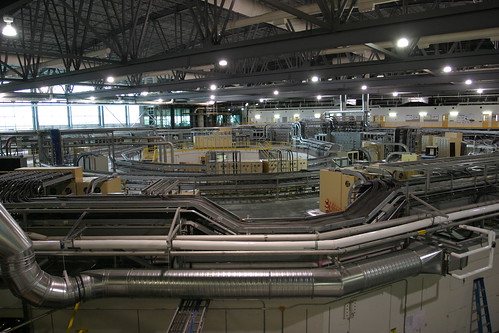(currently listening to: Fleet Foxes)
Hey internet.
I have emerged out of my cave!
Armed with only a powerpoint presentation (a hefty powerpoint, mind you-- with fancy animations[1]), I jumped through the first non-course-related hoop required for my degree: my 502!
I chose a topic that was both pretty nifty in my opinion and really out of my normal field of study.[2] Known as... the electrocaloric effect!
The electrocaloric effect is a solid-state cooling process that uses ferroelectrity. It is really spiffy for cooling things like portable electronics (because not everyone enjoys frying eggs on their laptop), since it scales down really nicely to applications where conventional refrigeration can't.
The electrocaloric effect is pretty similar to the process that occurs in magnetic refrigeration, which was the first method for getting really, really low temperatures (like, 0.3 K cold. Brrr.). Electricity is cheaper and easier to control than magnetic fields, and so the electrocaloric effect could be really applicable to consumer goods.
Another advantage that the electrocaloric effect has is that the materials involved that show significant cooling are widely industrially available and dirt cheap. I would not be surprised if there was a commercial application of this technique in the next 5-10 years, which is kind of nifty in comparison with a lot of outer-space seminars.
So, anyway. It's cool! Har-har, pun intended. The most recent report in the field came from Penn. State University in July, and got lots of attention, including a highlight in Scientific American.
Looking back on the whole process of learning, preparing a presentation and practicing it, I would have to say it was hella stressful, but worth all of the hard work. The hardest part was realizing just how much background information I had to go over. Annnd, the nomenclature was super confusing; I will never look again at the variables P and E without thinking about Polarization and Electrical Field for a second (instead of the chemically-normal Pressure and Energy).
Here's some references if you're interested in reading more about this:
1. Neese et. al, "Large Electrocaloric Effect in Ferroelectric Polymers Near Room Temperature," Science, 2008.
2. Mischenko et. al, "Giant Electrocaloric Effect in Thin-Film PbZr0.95Ti0.05O3," Science, 2006.
3. Mischenko et. al, "Giant electrocaloric effect in the thin film relaxor ferroelectric 0.9 PbMg1/3Nb2/3O3–0.1 PbTiO3 near room temperature," Applied Physics Letters, 2006.
Holla!
[1] I actually used Keynote instead of Powerpoint, which made my slides all magic and pretty. To be honest, I found Keynote to be decidedly un-Apple-like in its unintuitive interface, but it did have fancy transitions and animations. And really, isn't that what really these things are all about?
Friday, November 21, 2008
The electrocaloric effect!
Subscribe to:
Post Comments (Atom)

4 comments:
i love the electrocaloric effect!
thanks for all the information you provided on electrocaloric effect.
you're very welcome!
can anyone send me the information regarding mechanism of electrocaloric effect(any book name or materials) which considers the quantum effect...
ravi.s.r.c@gmail.com
Post a Comment